In the previous three lectures, we have dealt primarily
with rotation about a fixed axis or an axis moving
parallel to itself. What we saw in those lectures
was that dynamics of a rigid body is described by  and
in the absence of
and
in the absence of  the
angular momentum
the
angular momentum  is
a conserved. In the case of fixed axis rotation,
the relationship between the angular momentum
and the angular speed was quite straight forward
in that
is
a conserved. In the case of fixed axis rotation,
the relationship between the angular momentum
and the angular speed was quite straight forward
in that  and
all that was done in those problems was to change
the magnitude of ω to change L.
But the rotational motion is much more interesting
than that. For example
and
all that was done in those problems was to change
the magnitude of ω to change L.
But the rotational motion is much more interesting
than that. For example  is
a vector so it could change direction because
of applied torque with or without its magnitude
being affected. How the changing direction of
is
a vector so it could change direction because
of applied torque with or without its magnitude
being affected. How the changing direction of  affects
the orientation of a rigid body is one question
we should answer if we wish to understand the
motion of a rigid body. To start with, I want
to point out to you that rotational motion is
sometimes not what one would expect naively.
affects
the orientation of a rigid body is one question
we should answer if we wish to understand the
motion of a rigid body. To start with, I want
to point out to you that rotational motion is
sometimes not what one would expect naively.
You must have played with a top. If it is not spinning
and we try to make it stand on its pivot, it falls sideways.
On the other hand, if it is given a spin and then put
on its pivot point, it does not fall but starts to move
about, what is called precession, a vertical axis passing
through its pivot point. This is shown in figure 1. Obviously
the precession of the top has something to do with its
spin.
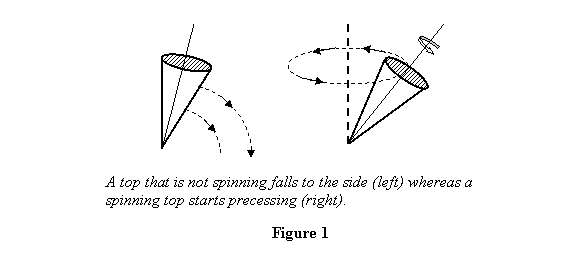
My second observation is from something that is seen in
science museums. You can also make it easily in your
local workshop. Take a track with many soft curves on
it and let three different shape rollers roll on it.
You may want to keep the track slightly tilted so that
the rollers roll by themselves. Question is which of
the rollers will be able to negotiate all the curves.
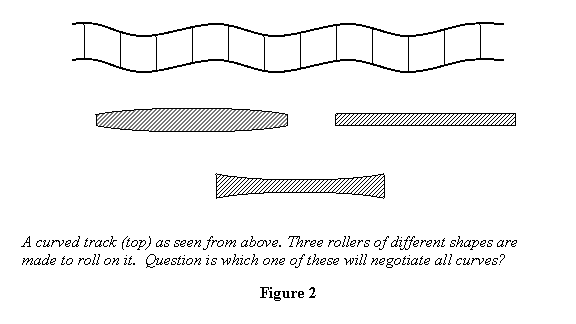
I make the third observation on a rectangular box of sweets
(empty of course) or any similar box. Put a rubber-band
around it so that its lid does not come off. Hold the
box at a height with one of its faces perpendicular to
the vertical, give it a spin and let it drop (see figure
3). Observe how its spin changes when it is falling down.
You will find that in two out of three possible ways
of holding the box, its spin will remain essentially
unchanged whereas in one case it will start wobbling.
On the other hand, if the box is dropped without giving
it a spin, it comes down in the same orientation. What
does the spin do to it? We wish to understand this.
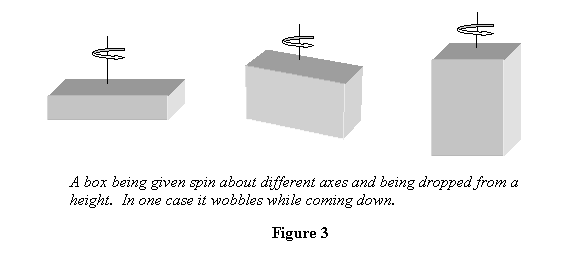
In all three cases we see that when an object is given
a spin its motion is very different compared
to when it is not spinning. This happens because
the angular momentum of the object due to its spin
changes direction during the motion and the orientation
of the body changes accordingly. So we now really
have to get into the vector nature of angular momentum
and relate it to the parameters - the
angle and the angular speed / velocity - of the
body. I develop this structure of three-dimensional
rigid-body dynamics step-by-step. The first question
we address in this development is if the angle
of rotation θ can
be expressed as a vector  ?
And if the answer is yes, what is its direction?
?
And if the answer is yes, what is its direction?
The answer to the question whether an angle of rotation
can be treated as a vector is in the negative.
This is because it fails to satisfy a fundamental
property - that
the addition of vectors is commutative - of vector
addition. Thus if we make two rotations of angles θ1 and θ2 about
two different axes, the end results will not be the
same if the order of rotations is changed. This is
depicted in figure 4 where I show a rectangular box
that is to be rotated by 90° about the x and
the y axes. The x and y axes
are in the plane of the paper and pass through
the centre of the box; the z-axis is coming out
of the paper. The results are different if (a)
I do the rotation about the x-axis first and
then follow it with a rotation about the y-axis,
and (b) I do the rotation about the y-axis first
and then follow it with a rotation about the
x-axis. Thus θ1 and θ2 cannot
be treated as vectors because  .
.
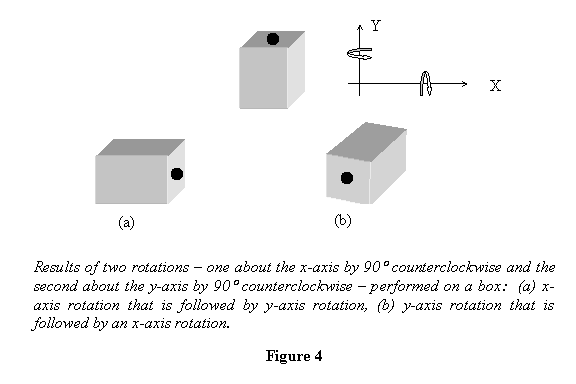
Mathematically let us take a rod of length l lying
along the x-axis with one of its ends at the
origin so that the (xyz) coordinates of
its other end are (l, 0, 0). Keeping its
end at the origin fixed, the rod is rotated about
the x and the y axes
in the same manner as the box in figure 4. If
rotated about the x-axis first the end still has
coordinates (l, 0, 0). Now the rotation
about the y-axis makes the rod align with the z-axis
with the new coordinates of its end being (0,
0, - l) . Let
us perform the rotations in the other order now.
The first rotation is performed about the y-axis
and makes the rod align with the z-axis with the
new coordinates of its end being rod (0, 0, -
l) .
Now the rotation about the x-axis makes the rod
align with the y-axis and the final coordinates of
its end are (0, l, 0) . Thus we see that
two rotations have absolutely different effect on
the orientation of a body depending on their order.
This is demonstrated in figure 5. The conclusion
therefore is that rotations
in general cannot be treated as vectors .
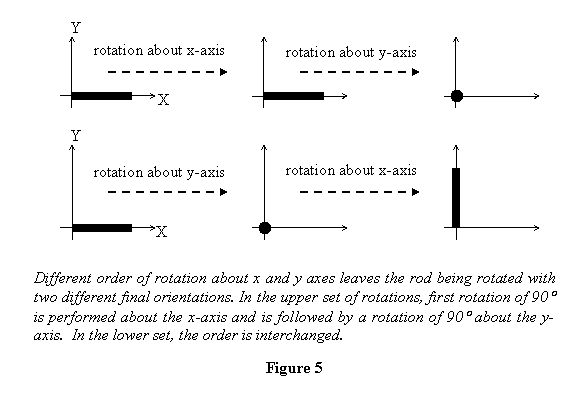
Although rotations by a finite angle are no vector
quantities, rotations by infinitesimal angles Δθ are.
This also makes the derivative  a
vector quantity. We therefore call this quantity
angular velocity rather than angular speed. Let
me first show you through a simple example that
infinitesimal rotations do satisfy the commutative
property of vector addition and then go on to
assign a direction to such rotations.
a
vector quantity. We therefore call this quantity
angular velocity rather than angular speed. Let
me first show you through a simple example that
infinitesimal rotations do satisfy the commutative
property of vector addition and then go on to
assign a direction to such rotations.